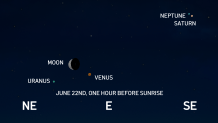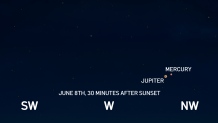
What's happening in the skies over North Texas this month? June holds some spectacular sights in the night and morning sky. Check out the list below.
A MORNING SHOW WITH VENUS, SATURN, NEPTUNE AND URANUS
Watch NBC 5 free wherever you are
In June, Venus, the brightest planet, will dominate the eastern sky before sunrise. There are two ways to appreciate Venus in the predawn sky: with the naked eye or with a telescope.
Neptune is located about 1.9 billion miles beyond Saturn. On June 29, it is exactly one degree due north of Saturn. You'll need a pair of binoculars to view it to the upper left of Saturn.
Get top local stories delivered to you every morning with NBC DFW's News Headlines newsletter.
Uranus will join Venus in the morning sky by the end of the month. The best time to view the planet is June 30, when it stands 5 degrees northeast of Venus.

Venus's distance from the Earth varies from 24 million miles to 162 million miles.
Saturn's distance varies from the Earth. When the two are closest, they lie approximately 746 million miles apart, or eight times the distance between the Earth and the sun. At their most distant, when they lie on opposite sides of the sun from one another, they are just over a billion miles apart, or 11 times the distance between the Earth and the sun.
When Neptune and the Earth line up on the same side of the sun, they are only 2.7 billion miles apart at their closest. But when the planets are on opposite sides of the sun, they can put as many as 2.9 billion miles between them.
AN EVENING DELIGHT WITH JUPITER AND MERCURY
Jupiter joins Mercury in the early evening hours, with both setting quickly. Jupiter will hang low in the western sky at the beginning of the month. It becomes visible about 20 minutes after sunset, standing eight degrees high. Each day, it becomes harder to see, but Mercury joins it from June 6-9.
The pair of bright planets sits about three degrees above the western horizon 30 minutes after sunset. They will sit together for about 25 minutes.

Jupiter is lost from view by the end of the month. It’ll reappear in the morning sky in late July. Meanwhile, Mercury continues to climb higher in the evening sky.
Jupiter's distance from the Earth varies from 336 million miles to 600 million miles. Mercury's distance from the Earth varies from 48 million miles to 137 million miles.
THE SUMMER SOLSTICE
In the Northern Hemisphere, the summer solstice occurs when the sun travels along its northernmost path in the sky. This marks the astronomical start of summer in the northern half of the globe. In the Southern Hemisphere, it’s the opposite: the summer solstice marks the astronomical start of winter when the sun is at its lowest point in the sky.

The summer solstice occurs on Friday, June 20, at 9:42 p.m. CDT.
This solstice occurs when Earth arrives at the point in its orbit where the North Pole is at its maximum tilt (about 23.5 degrees) toward the sun, resulting in the longest day and shortest night of the calendar year.
| Year | Summer Solstice (Northern Hemisphere) | Summer Solstice (Southern Hemisphere) |
|---|---|---|
| 2025 | Friday, June 20 at 9:42 P.M. CDT | Sunday, Dec. 21 |
| 2026 | Sunday, June 21 at 3:24 A.M. CDT | Monday, Dec. 21 |
| 2027 | Monday, June 21 at 9:11 A.M. CDT | Tuesday, Dec. 21 |
| 2028 | Tuesday, June 20 at 3:01 P.M. CDT | Thursday, Dec. 21 |
A JUNE FULL MOON
The June full moon, known as the Strawberry Moon, will make for a delight at the beginning of the month.

The name, Strawberry Moon, originates from the Algonquin tribes. This is because June is traditionally a time when wild strawberries are ready for harvest in North America.
The full moon will begin to appear on the evening of Tuesday, June 10, and will last through the morning of Wednesday, June 11. On June 11 at 2:43 a.m. CT, the moon will appear at its brightest for the last time this spring.
MOON PHASES
The eight moon phases of a lunar month are divided into four primary and four intermediate (waxing and waning) moon phases.

NEW MOON: The new moon is when the sun and moon are aligned, with the sun and Earth on opposite sides of the moon.
There are two reasons why we can’t see the new moon:
The new moon is up in the daytime sky. It rises and sets around the same time as the sun. Thus, bringing it too close to the sun's glare to be seen.
WAXING CRESCENT MOON: This intermediate moon phase occurs after the new moon and lasts until the first quarter moon.
![[UGCDGO-CJ-back to school]Crescent Moon Tonight](https://media.nbcdfw.com/2019/09/6703538a7ee246a98edc827cad2b5055.JPG.jpg?quality=85&strip=all&resize=218%2C123)
FIRST QUARTER: The first quarter moon occurs when half of the moon’s face is lit up. Whether the lit-up half appears on the left or right depends on where you are on Earth.
WAXING GIBBOUS MOON: This intermediate moon phase occurs after the first quarter moon and lasts until the full moon.
FULL MOON: A full moon is when the entire face of the moon is lit up. The moon is in constant motion around the Earth, so a full moon only lasts for an instant of time.
WANING GIBBOUS MOON: This intermediate moon phase occurs after the full moon and lasts until the third quarter moon.
THIRD QUARTER: The third quarter moon is when the opposite half of the moon is illuminated compared to the first quarter. Whether the lit-up half appears on the left or right depends on where you are on Earth.
WANING CRESCENT MOON: This intermediate moon phase occurs after the third quarter moon and lasts until the new moon.
ELLIPTICAL ORBIT
The moon's orbit around Earth is elliptical, with one side either closer to or farther from Earth. On June 7 at 5:43 a.m. CDT, the moon will be at apogee, its farthest to the Earth for this orbit at 251,999 miles. On June 22 at 11:41 p.m. CDT, the moon will be at perigee, its closest to the Earth for this orbit at 225,670 miles.
HOW FAR WILL THE EARTH TRAVEL AROUND THE SUN THIS MONTH?
First, the Earth's spin is constant, but the speed depends on the latitude at which you are located. For example, at the equator, the speed is about 1,037 mph.
Earth's spin, of course, is not the only motion we have in space. Our orbital speed around the sun is about 67,000 mph. That's the equivalent of traveling from London to New York in about three minutes.

In our orbital voyage around the sun, we've traveled 340.66 million miles by the end of June. Only 243.33 million miles to go!
Please enjoy these events in the night sky this month. Until then, Texans, keep looking up!




